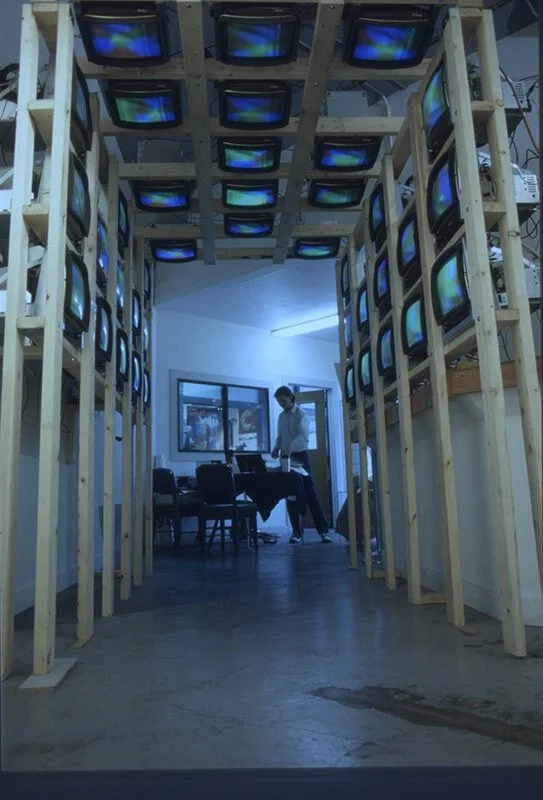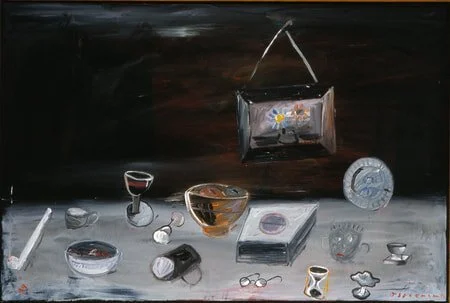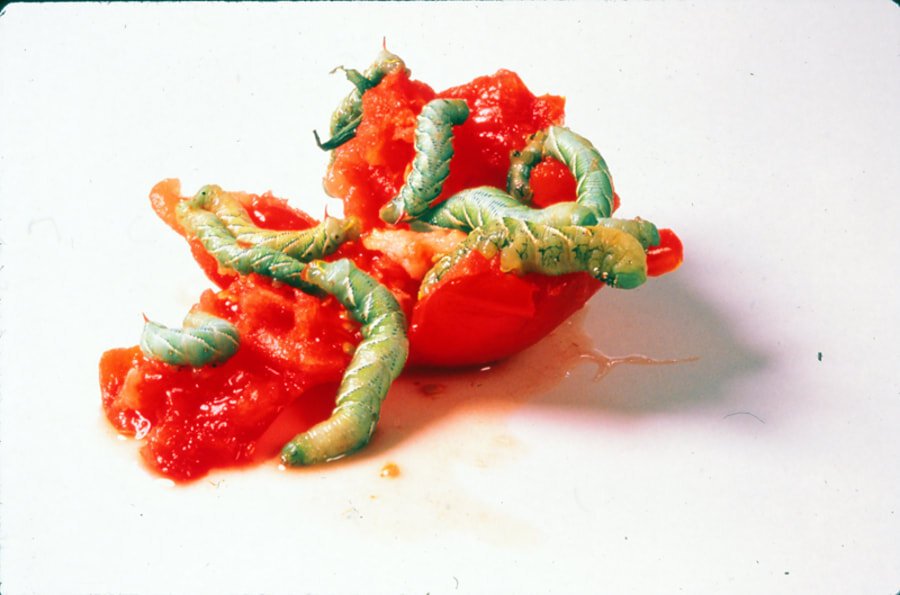CoCA Digital Archive:
1996-1999
1996
Gender, fucked
Exhibition Dates: June 28-August 23,1996
Location:65 Cedar Street in Seattle's Belltown neighborhood
Curator: Catherine Lord and Harmony Hammond
Artist: Amy Adler, Deborah Bright, Patricia Cronin, Shauna Dempsey & Lorri Millan, Elise Dodeles, Dyke Action Machine, Nicole Eisenman, Donna Evans, Fierce Pussy, Maria Elena Gonzalez, Deborah Kass, Mary Klein, Lesbian Avengers, Sue Maberry & Cheri Gaulke, Carrie Moyer, Catherine Opie, Hanh Thi Pham, Marcia Salo, Jocelyn Taylor, Nicola Tyson, Linn Underhill.
-
"Gender, fucked" showcased 23 lesbian artists investigating the subject of gender. The curators felt passionate about creating an all lesbian exhibition to give visibility to a group often erased "from a 'queer' culture dominated by gay men and feminist culture dominated by heterosexual women" (Catherine Lord and Harmony Hammond). The exhibit took place from June 28 to August 23, 1996, at CoCA's Gallery located at 65 Cedar Street. Various events were held throughout the show, including a Gallery Talk and Discussion, a Slide Night for Lesbian Artists, and a concert titled Gender, ROCKED!, which took place in the gallery’s alleyway. Due to the show’s explicit name, CoCA struggled with shipping show announcements and artwork. The National Campaign for Freedom of Expression was called upon to aid CoCA with these matters.
We found a great article, titled "Exhibiting Gender" by David Joselit in the Art in America archives that discusses "Gender, fucked."
Added 05/10/17
Japan-O-Rama
Exhibition Dates: January 26 - March 3, 1996
Location: 65 Cedar St, in the Belltown neighborhood of Seattle
Curator: Clarke Fletcher
-
Japan-O-Rama provided a view into contemporary Japanese pop culture through the works of Japanese writers, musicians, filmmakers and comic artists, as well as U.S. and Canadian artists influenced by Japanese culture. Japan-O-Rama featured work by Tezuka and Mr. Onishi, design by Shawn Wolfe and Art Donnely, music by Jeffrey Taylor and James Wood, and featuring performances by Seagull Screaming, Kiss Her Kiss Her, Live Nude Girls, and Muddy Frankenstein.
Events during the exhibit included Hello Kitty Arch & Fountain, Japan-O-Rama Arcade & Retail Starship, retail environment Why Not, Japan-O-Rama Fashion Show lead by designer Maria Carr at The Catwalk Club(174 S. Washington St.), Japan-O-Rama Thrillshow Spectacular, and a weekly Tuesday Night Animae Series.
Added 05/02/18
Nirvana Capitalism and the Consumed Image
Exhibition Dates: October 11-December 7, 1996
Location: 65 Cedar Street in Seattle's Belltown neighborhood
Curator: Susan Purves and Bradley Thompson
Artists: Alex Bag, Mark Bennett, Kim Colimer, Sandra Smith, Jennifer Davy, Steve Davis, Dawn DeDeaux, Richard Hawkins, Karen Kilimnik, Alan Lande, Paul Lee, Catherine Opie, Isabel Samaras, Igor Vamos, Gregory Haun, Marchall Weber
-
The concept for this exhibit stemmed from Guy Debord's "Society of Spectacle" and the Situationist International in the 1960s. Debord explains the "spectacle" as the relationship people have formed with commodities. The focus of the exhibit was on consumerism, advertising, music, fashion and its influence on people’s lives. This exhibit included installation, video, performance, discussion, and other art works from regional and national artists.
Added 5/4/2018
1997
Square Painting/Plane Painting
Exhibition Dates: January 10 - March 8
Location: 65 Cedar Street Seattle
Artists: Thomas Nozkowski, Jake Berthot, John Dunn, Denzil Hurley, Alfonse Borysewicz, Keiko Hara, Jacqueline Barnett, Susan Frecon, Mary Henry, Paul Mogenson, Dan May, Robert C. Jones
Curator: Lauri Chambers
-
Curated by Lauri Chambers, Square Painting/Plane Painting featured a collection of abstract paintings in the vein of Russian artists Kasimir Malevich and Wassily Kandinsky. Square Painting/Plane Painting received a positive reaction from the press. Art critics who were bewildered by some of the more unusual exhibitions at CoCA were pleased to return to the one of the standbys of modern art, abstract paintings. Seattle PI art critic Regina Hackett praised the works of most of the artists, referring to them as “invoking an ineffable quality of mind [and] heart,” but criticized the layout of the exhibition, which
she felt prevented more established artists from achieving their true potential.
Added 5/8/2019
Jay Steensma
Exhibition Dates: March 28 - May 24
Location: 65 Cedar St, Seattle
Curator: Matthew Kangas
Artist: Jay Steensma
-
Jay Steensma has been described as one of the more famous and one of the more controversial artists in the Seattle area during the latter part of the 20th century. Described by some as a later-day exponent of the Northwest School, Steensma was an extremely prolific painter whose contents often included chalices, snakes, houses, clouds, birds, and fish. His erratic behavior, largely resulting from bipolar disorder, made him many enemies and occasionally led to his institutionalization, but he overcame these challenges to have his paintings portrayed in art museums all over the Pacific Northwest, and even in the Smithsonian Institution. After Steensma's death in 1995, Matthew Kangas decided to hold a retrospective of his works, which was met with as much controversy as Steensma itself, described by Seattle PI critic Regina Hackett as "wretchedly weak" at times, but also "stark and powerful."
Added 4/24/2019
The People's Choice Project: Seattle's Most Wanted Painting
Exhibition Dates: September 26 - November 8, 2017
CD Release Party: October 24
Location: 65 Cedar Street in Seattle's Belltown neighborhood
Curator: Susan Purves
Artists: Vitaly Komar and Alexander Melamid
-
CoCA presented an exhibition by Vitaly Komar and Alexander Melamid, two New York-based conceptual artists (they had emigrated to the United States in 1978) that were paid a fee plus air fare to come out and create a 20’ x 10’ installation of many separate canvases (polyptych) based on crowd-sourced content and incorporating music, smells, copies of the People’s Choice Poll, and a 3D element. The show also involved a collaboration with the Henry Art Gallery to exchange displayed content. For CoCA, a group of 200 citizens gathered at the University Methodist Church and provided ideas. The result, as Sheila Farr wrote (Seattle Weekly, Oct. 1, 1997), was simply "bad art," and as Regina Hackett surmised, CoCA was finding a "new way to embarrass itself" (Seattle PI, no date on press clipping). True to form, the organization was engaging controversial content, pushing the definition of what contemporary art was in the first place.
The show also coincided with the CD release of “America’s Most Wanted Song,” during the opening exhibition, and with express permission and sponsorship of DIA Arts Center Director Michael Govan (correspondence in files confirms all this). America's Most Wanted Song involved Komar & Melamid with composer David Soldier; the project debuted in Seattle thanks to an "anonymous Northwest art patron."
Komar and Melamid debuted the concept at the Alternative Museum in New York in 1994 and sought to have it (or themselves, as it were) travel afterward. The artists would poll the public and from the most popular responses, make an artwork. (America's most wanted painting was a "dishwasher-sized autumnal landscape, predominantly blue, with wild animals and a group of fully clothed people at leisure." Mary Abbe, Minneapolis Star Tribune, March 20, 1994).
Melamid was also asked to serve as juror for the 1997 NW Annual and his role-of-the-dice method of jurying seemingly precipitated a series of calamities: by December of that year, the departure of Executive Director Susan Purves was announced in The Seattle Weekly (by Roger Downey) along with speculation that a "shakeup" indicated that CoCA had "slid over" the cutting edge and was on the decline.
As CoCA’s press release for the 1997 Northwest Annual summarized, “The work of Komar and Melamid, underneath its conceptual bravura and ironic gloss, poses questions about the place of the artist in modern society. From purchasing people's souls via mail-order to creating a painting school for homeless elephants in Thailand, Komar & Melamid seek truth through the ridiculous.”
YouTube recording of America's Most Wanted Song
Added 12/30/17
They Came Here First
Exhibition Dates: June 21- August 16, 1997
Location: 65 Cedar Street Seattle, WA 98121
Curator: Center on Contemporary Art
-
The exhibition was in celebration of the 50th anniversary of the first flying saucer sighting—June 24, 1947 over Mt. Rainier, Washington. An opening celebration for this exhibit was held on June 21 to commemorate the first appearance of The Men in Black. The exhibit displayed contemporary art, collectibles, and commercial art inspired or influenced by UFO phenomena. Northwest artists were invited to create works inspired by UFOs and aliens. After its opening, the exhibit was presented at the 1997 Bumbershoot Festival.
Added 5/4/2018
1998
Love at the End of the Tunnel, or the Beginning of a Smart New Day
Exhibition Dates: February 7 - April 4, 1998
Location: 65 Cedar Street in Seattle's Belltown neighborhood
Curator: Marilu Knode
Artists: Maura Bendett, Andrea Bowers, Sally Elesby, Chris Finley, Terri Friedman, Michael Gonzalez, Doug Hammet, Joyce Lightbody, Carlos Mollura, Patrick Nickell, Michael Pierzynski, Kenneth Riddle, George Stoll, and Pae White.
-
Focusing on emerging artists from Los Angeles, this large group exhibition was guest curated by Marilu Knode (Senior Curator at Institute of Visual Art, University of Wisconsin-Milwaukee at the time, and eventually Executive Director at the Laumeier Sculpture Park [2010-2016]). The year before Tunnel, Knode also served as curatorial coordinator for CoCA's They Came Here First (1997) and seems to have either been on the board or had significant involvement with the organization.
Together with Survival System Train & Other Sculpture: Kenji Yanobe (also 1998) and the group show At the Treshold of the Visible (1998 again) clearly establishes the strong connection between CoCA and Los Angeles at this time that is well worth highlighting and exploring for the development of late 20th c. contemporary art on the west coast. Many of the artists went on to national careers, including Pae White (solo show at the Henry in 2002). Maura Bendett, another artist in the show, had previously been reviewed in Art in America (December 1997; clipping in file). Likewise, Andrea Bowers' work had been reviewed by Michael Darling in LA Art Week (1995; ditto); in another interesting twist, Darling eventually became curator of contemporary art at Seattle Art Museum.
Knode’s curatorial statement offers a summary of what the show offered the Seattle arts community: "The artists in Love at the End of the Tunnel, or the Beginning of a Smart New Day were born into a world where a smart, decrepit, racy and worn-out LA represented a dream-land, perfect because it was unfulfilled, undercapitalized and on the brink of tomorrow. All the aesthetic, and ascetic, forms in Love at the End of the Tunnel know the art lingo -- the 1970s body work, the fetishism of obsessive work, anti-materialism -- as well as the 1980s shtick -- hypermaterialism, egomania, cool neo-geo, inescapable consumerism. Everywhere is the imprint of an historical freedom, a bonus climate in experimentation and absolution. The work is small; the ideas are big."
Added 12/30/17
1999
Food Chain: Encounters Between Mates, Predators, And Prey
Exhibition Dates: April 9 - May 22, 1999
Location: 65 Cedar Street, Seattle
Curator: Michael Sand
Artist: Catherine Chalmers
-
Catherine Chalmers exhibited the brutality and dog-eat-dog ruthlessness of nature in Food Chain: Encounters Between Mates, Predators, and Prey, with a series of photographs of various creatures eating and being eaten by one another. The eating involved in the pictures demonstrates the cycle of life sometimes with vivid, almost gory, detail. For example, one set of pictures features a caterpillar feasting on a tomato, which then gets eaten by a praying mantis, which then gets eaten by its mate at the climax of their intercourse. Other photographs reveled in the miracle of birth and juxtaposed that miracle with its inevitable corollary, death. In so doing, Chalmers reminded her viewers that despite all the pretenses that we have created through our civilization, the world is a cruel, brutal, and pitiless place where the weak are swallowed up by the strong, and the strong are swallowed up by the stronger. The exhibition was curated by Michael Sand.
Added 5/13/2019




